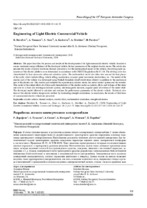| dc.contributor.author | Dorofeev, R. | |
| dc.contributor.author | Tumasov, A. | |
| dc.contributor.author | Sizov1, A. | |
| dc.contributor.author | Kocherov, A. | |
| dc.contributor.author | Meshkov, A. | |
| dc.contributor.author | Porubov, D. | |
| dc.coverage.spatial | Минск | ru |
| dc.date.accessioned | 2020-02-04T09:28:52Z | |
| dc.date.available | 2020-02-04T09:28:52Z | |
| dc.date.issued | 2020 | |
| dc.identifier.citation | Engineering of Light Electric Commercial Vehicle = Разработка легкого коммерческого электромобиля / R. Dorofeev [et al.] // Наука и техника. – 2020. – № 1. – С. 63-75. | ru |
| dc.identifier.uri | https://rep.bntu.by/handle/data/63823 | |
| dc.description.abstract | The paper describes the process and results of the development of the light commercial electric vehicle. In order to ensure maximum energy efficiency of the developed vehicle the key parameters of the original electric motor. The article also presents the results of power electronic thermal calculation. For the mathematical model of the vehicle, the driving cycle parameters of the electric platform were determined in accordance with UNECE Regulations No 83, 84. The driving cycle was characterized by four successive urban and suburban cycles. The mathematical model also takes into account the time phases of the cycle, which include idling, vehicle idling, acceleration, constant speed movement, deceleration, etc. The model of the electric part of the vehicle was developed using MatLab-Simulink (SimPowerSystems library) in addition to the mechanical part of the electric car. The electric part included the asynchronous electric motor, the motor control system and the inverter. This model at the output allows to obtain such characteristics of the electric motor as currents, flows and voltages of the stator and rotor in a fixed and rotating coordinate systems, electromagnetic moment, angular speed of rotation of the motor shaft. The developed model allowed to calculate and evaluate the performance parameters of the electric vehicle. Technical solutions of the electric vehicle design were verified by conducting strength calculations. In conclusion, the results of field tests of a commercial electric vehicle are presented. | ru |
| dc.language.iso | en | ru |
| dc.publisher | БНТУ | ru |
| dc.title | Engineering of Light Electric Commercial Vehicle | ru |
| dc.title.alternative | Разработка легкого коммерческого электромобиля | ru |
| dc.type | Article | ru |
| dc.identifier.doi | 10.21122/2227-1031-2020-19-1-63-75 | |
| local.description.annotation | В статье описаны процесс и результаты создания легкого коммерческого электромобиля. С целью обеспечения максимальной энергоэффективности разрабатываемого транспортного средства определены основные параметры оригинального электродвигателя. Представлены результаты теплового расчета силовой электроники. Для математической модели транспортного средства определены параметры ездового цикла электрической платформы в соответствии с Правилами № 83, 84 ЕЭК ООН. Цикл движения характеризовался четырьмя последовательными циклами городского и пригородного режимов движения. Математическая модель также учитывает временные фазы цикла, которые включают холостой ход транспортного средства, ускорение, движение с постоянной скоростью, замедление и т. д. Модель электрической части транспортного средства разработана с использованием MatLab-Simulink (библиотека SimPowerSystems) в дополнение к механической части электромобиля. Электрическая часть включала асинхронный электродвигатель, систему управления двигателем и инвертор. Данная модель на выходе позволяет получить такие характеристики электродвигателя, как токи, поведение магнитного поля, напряжения статора и ротора в неподвижной и вращающейся системах координат, электромагнитный момент, угловая скорость вращения вала двигателя. Разработанная модель позволила рассчитать и оценить параметры производительности электромобиля. Технические решения конструкции электромобиля были проверены на прочность путем расчетов. Представлены результаты полевых испытаний коммерческого электромобиля. | ru |

